Resource Management Technologies - Solar PV Recycling, Reuse and Redistribution Programs, and LCA Approach to Waste Management Systems
I will be addressing questions related to the end-of-life phase of solar panels in the U.S. This will include the estimated and forecasted number of solar panels installed, the lifespan of PV modules, and organizations like Reuse Development Organization Inc. (ReDO). I will also discuss successful reuse programs such as the "LIFT" program, Soles 4 Souls, and the Cooling Pack reuse program. Additionally, I will outline the major steps involved in the Life Cycle Assessment (LCA) of waste management systems.
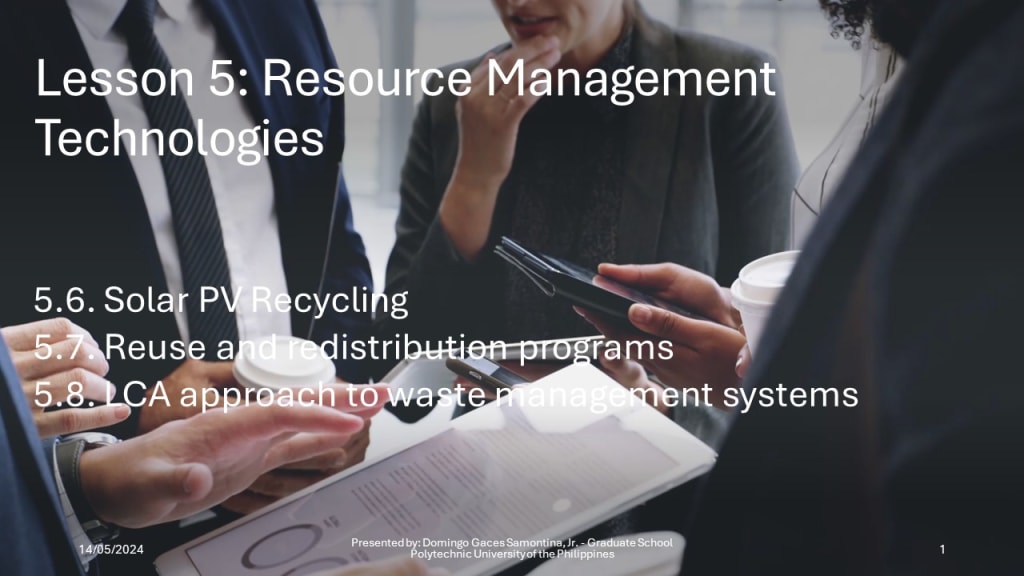
5.6 Solar PV Recycling
The global installation of an estimated 500,000 solar panels per day in 2015 reflects the rapid growth of solar power. In terms of residential usage, a typical American home may require 28 to 34 solar panels to meet its power needs. Looking ahead, the U.S. Department of Energy projects a cumulative installation of 700 GW of solar power by 2050, equivalent to hundreds of billions of PV modules (Mulvaney, 2015).
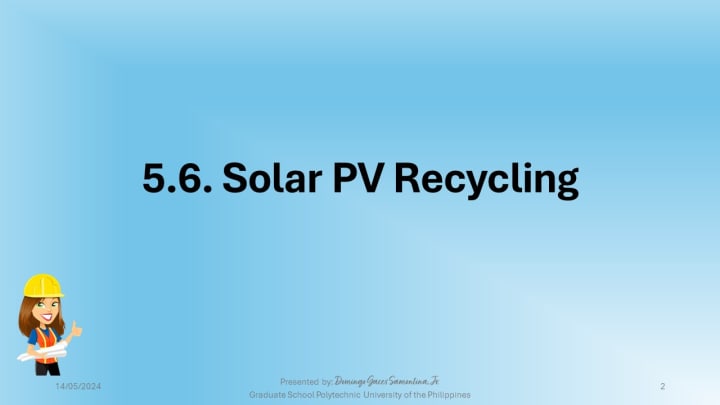
The solar power industry, according to the Solar Energy Industries Association (SEIA) and Wood Mackenzie Power & Renewables, has experienced an impressive average annual growth rate of approximately 59% over the past decade.
- Solar Energy Industries Association (SEIA). Solar Industry Research Data | SEIA
- Mulvaney, D., Act Now To Handle The Coming Wave Of Toxic PV Waste, Solar Industry Mag 2015. Accessible from URL: https://solarindustrymag.com/
But here is the question: What will happen to the billions of those solar panels now spreading across the globe at the end of their useful lives?
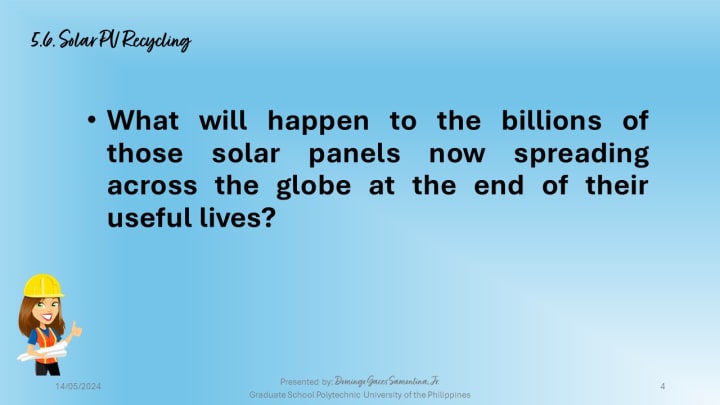
With this, I used the platform QUORA a social question-and-answer website and online knowledge market to ask few members about the subject matter and came up with the following answers:
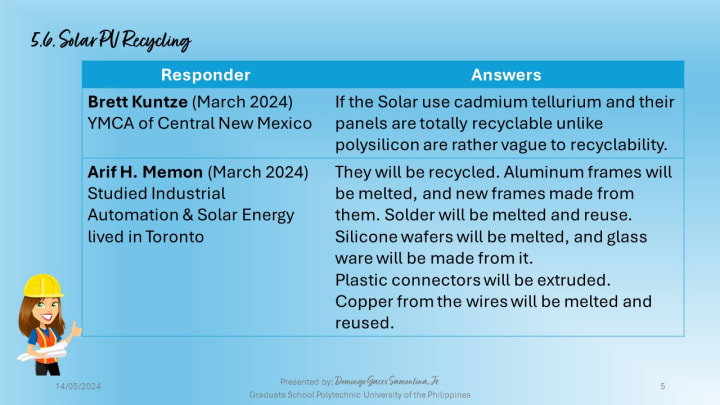
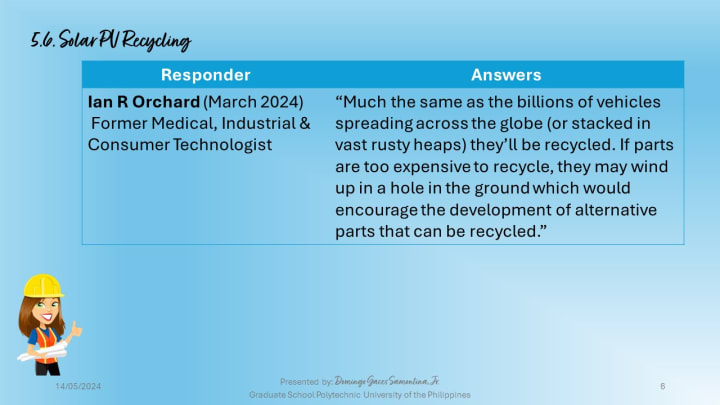
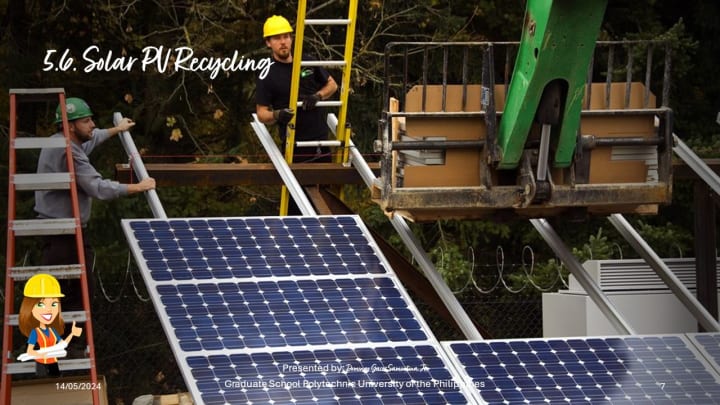
This photo is from the Oregon Department of Transportation. The rapid growth of photovoltaic installations over the past decade requires radical action to establish a robust and economically viable PV disposal and recycling system.
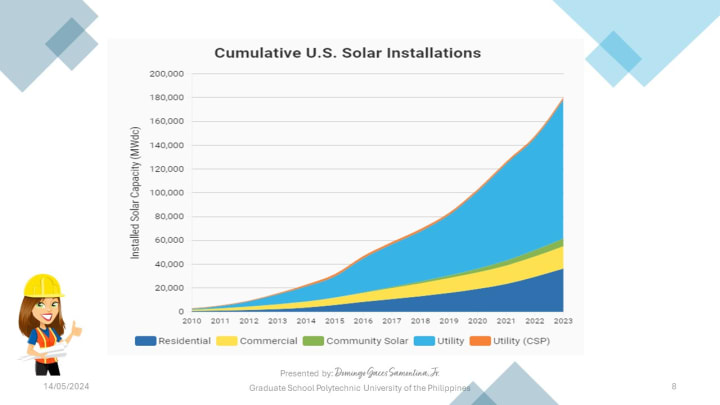
The graph illustrates the increasing trend of cumulative U.S. solar installations from 2010 to 2023, with a projected 180,000 installed solar cells by 2023, as reported by the Solar Energy Industries Association (SEIA).
Considering the average 25- to 30-year lifespan of solar photovoltaic (PV) modules, it's important to anticipate the first peak of PV waste around 2030 due to current growth rates. To address this, the industry must prioritize the development of recycling methods, infrastructure, and policies to ensure the sustainable use of valuable metals and materials found in photovoltaic panels. By doing so, we can effectively manage waste and mitigate resource depletion concerns.
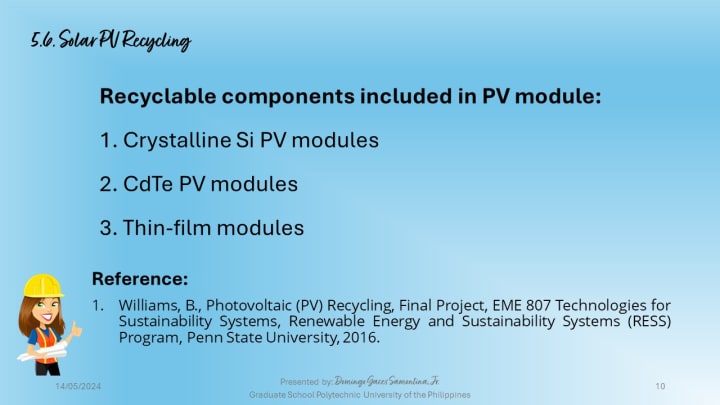
There are a number of recyclable components included in PV module – some of those are rare, and some of those are toxic and thus require a proactive plan for recycling.
- Crystalline Si PV modules - in addition to silicon, contain materials such copper, aluminum, silver, and glass.
- CdTe PV modules - contain cadmium, steel, and copper.
- Thin-film modules - elements as tellurium, indium, gallium, and molybdenum, which are in limited supply in the Earth’s crust
Williams, B., Photovoltaic (PV) Recycling, Final Project, EME 807 Technologies for Sustainability Systems, Renewable Energy and Sustainability Systems (RESS) Program, Penn State University, 2016.
There are Two Type of PV Panels:
- Deutsche Solar
- First Solar - including LCA considerations and cost analysis.
Supplemental Reading:
Journal publication: Kim, S., Jeong, B., Closed-Loop Supply Chain Planning Model for a Photovoltaic System Manufacturer with Internal and External Recycling, Sustainability 2016, 8(7), 596.
URL: https://www.mdpi.com/2071-1050/8/7/596
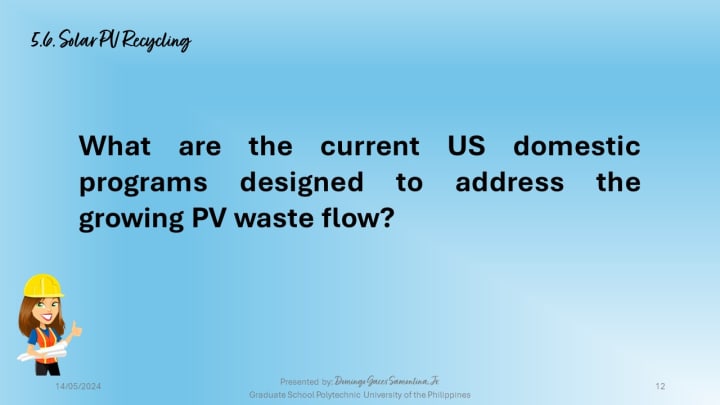
Until recently, the regulations on PV waste did not exist in the USA, except California.
Rather than providing a summary of this section, the video below delves into emerging options and initiatives, many of which draw from the successful experience of European recycling programs.
The video emphasizes the importance of addressing the growing issue of solar panel recycling, even though end-of-life panels may not need recycling for another 15 years. It offers valuable insights into the current state of U.S. solar panel recycling. The video can be found on YouTube and was published on February 6, 2019, by Solar Power World.
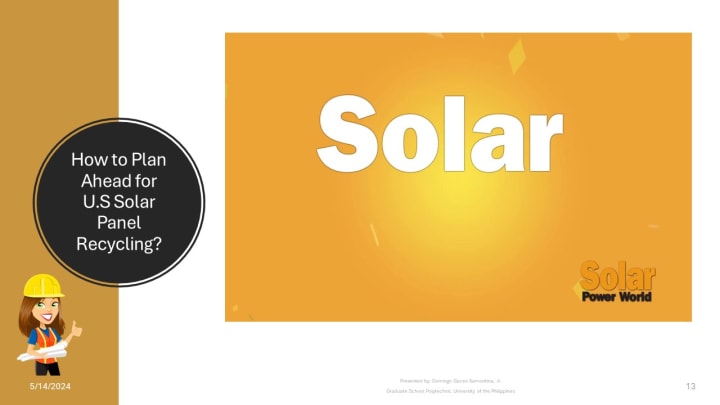
Additional Readings
Web Article: Lozanova, S., Are Solar Panels Recyclable, Earth 911, 2018. URL: https://earth911.com/eco-tech/recycle-solar-panels/(link is external)
Web Article: Marsh, J., Recycling Solar Panels in 2018, EnergySage, 2018. URL: https://news.energysage.com/recycling-solar-panels/
The provided text highlights the available options for PV recycling in both the US and Europe. For instance, it mentions that "PV Cycle, a European solar panel recycling association, has developed a highly efficient mechanical and thermal treatment process that achieves an impressive 96% recovery rate for silicon-based photovoltaic panels." This is a significant step forward in sustainable technology. Furthermore, it's noted that "the remaining 4% is repurposed in an energy recovery process using waste-to-energy technology," showcasing a comprehensive approach to minimizing waste in the solar industry.
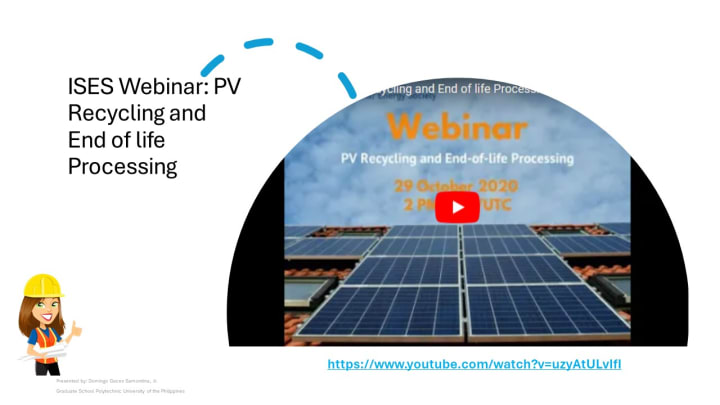
Don't forget to check out the "ISES Webinar: PV Recycling and End-of-Life Processing" on YouTube. This insightful video, published by the International Solar Energy Society (ISES) on November 4, 2020, runs for approximately 1 hour and 22 minutes.
The webinar offers a comprehensive overview of PV recycling practices, policies, and cutting-edge research developments from around the world. The first presentation delves into the legal background and policies across different countries. The second presentation explores the integration of PV panel reuse practices into the circular economy. Lastly, the webinar provides a detailed look at the recycling process, showcasing the equipment used for the mechanical, chemical, and thermal extraction of materials from discarded panels.
5.7 Reuse and Redistribution Programs
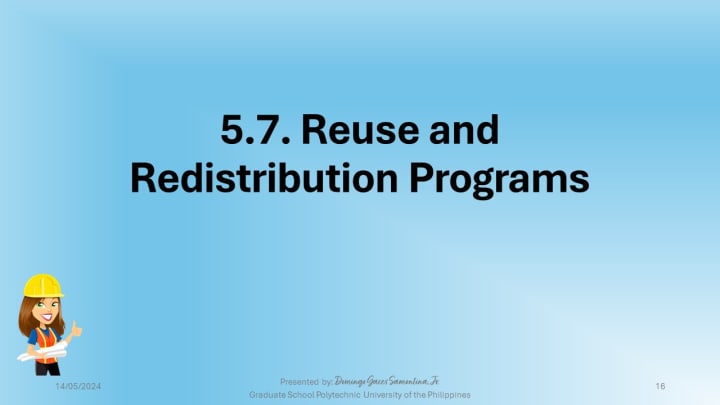
Embracing reuse as the second level of the national solid waste management hierarchy allows for the continuous use of products or components in their original form. By redistributing materials and products from those who no longer need them to those who can benefit from them, we not only conserve valuable natural resources but also ensure that materials and products reach disadvantaged people and organizations.
To gain more insight into this important issue, you can explore the ReDO company website.
https://loadingdock.org/redo/Benefits_of_Reuse/body_benefits_of_reuse.html
The US EPA provides grant funding to Reuse Development Organization Inc. (ReDO), a non-profit organization with the mission of promoting reuse as an environmentally sound, socially beneficial, and economical means for managing surplus and discarded materials.
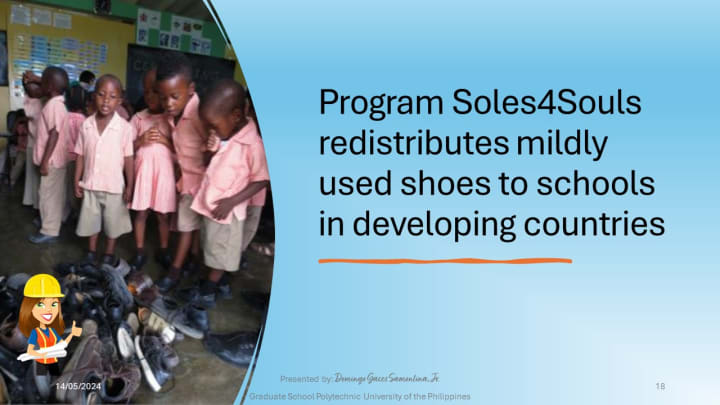
The picture depicts a successful material reuse program called Soles4Souls, which redistributes gently used shoes to schools in developing countries.
Here are a few examples of successful material reuse programs that aim to redirect useful resources away from the waste stream:
- "LIFT" reuse program
- Soles 4 Souls
- Cooling pack reuse program
"LIFT" Reuse Program
The program gratefully accepts gently used equipment designed for individuals with disabilities and ensures it reaches those in need. They meticulously inspect and sanitize all donated items to guarantee their safety.
https://liftcil.org/programs/reuse.html
Accepted items encompass a wide range, including walkers, wheelchairs, transfer chairs, raised toilet seats, shower chairs, adapted telephones, low-vision aids, reachers, and any other equipment that promotes independence.
Soles 4 Souls
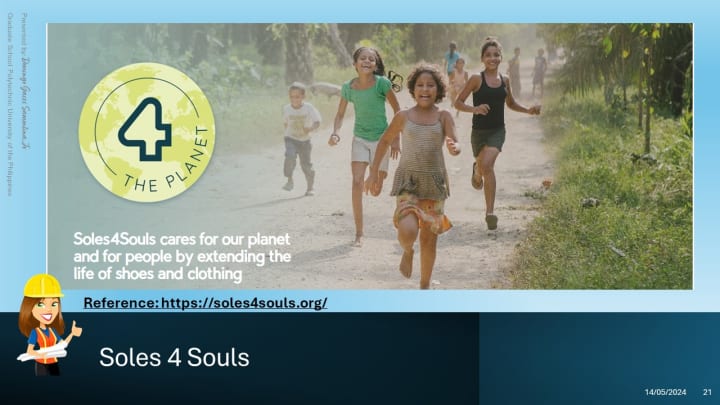
Transforming shoes and clothing into opportunities: When individuals lack the resources to meet their current needs, it hinders their ability to plan for the future. Soles4Souls transforms shoes and clothing into opportunities for education and employment, paving the way for a brighter future.

Soles4Souls is organizing an event called Race 4 Every Kid 2024, a virtual run, walk, swim, or bike to provide shoes to children in need. To discover more about this event or to participate, please click the link provided below:
Soles4Souls collaborates with schools nationwide to supply new athletic shoes to children facing homelessness, removing barriers to educational and extracurricular activities."
Cooling Pack Reuse Program
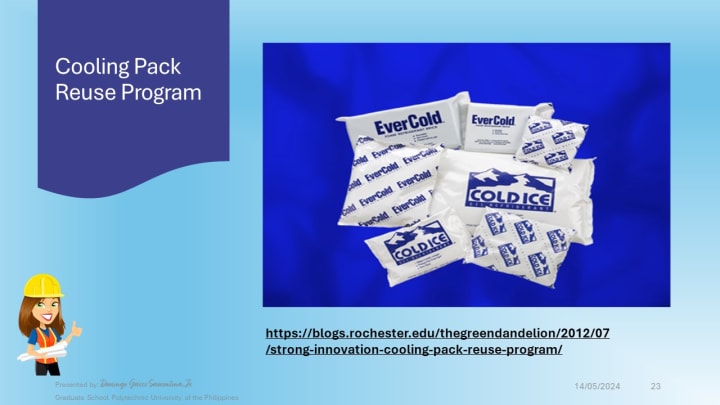
https://blogs.rochester.edu/thegreendandelion/2012/07/strong-innovation-cooling-pack-reuse-program/
The Strong Innovation: Cooling Pack Reuse Program at Strong Memorial Hospital (SMH) has been a successful initiative. Axel Kaires, an administrative assistant at the Blood Bank, observed a significant amount of wasted cooling packs. In response, Mr. Kaires and his colleagues began reusing the cooling packs by taking them home to keep drinks cool during family outings. Despite their efforts, a considerable number of cooling packs were still being wasted. Mr. Kaires took proactive steps and reached out to the university's recycling office. Through collaborative efforts, it was determined that the Meals on Wheels Association of America would benefit most from the excess cooling packs. The organization uses the cooling packs to preserve perishable food during transport as they provide meals to one million senior citizens.
5.8 LCA Approach to Waste Management Systems
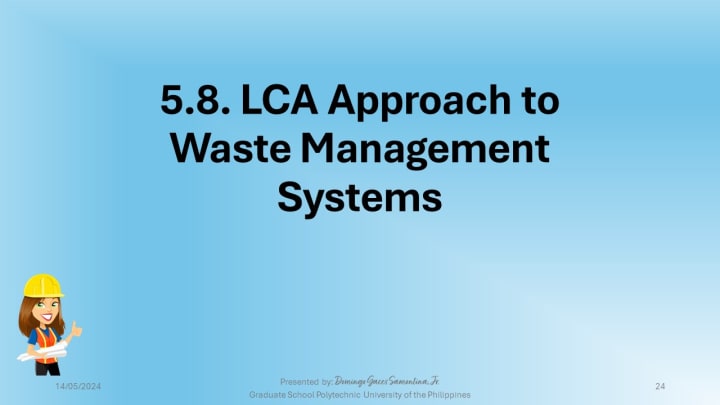
Life Cycle Assessment (LCA) is an essential analytical framework that evaluates resource consumption and the impact on human health and the environment during the manufacturing of specific products.
The application of LCA principles to waste management systems is crucial for ensuring a comprehensive understanding of relevant impacts without shifting problems. This approach allows for the identification of potential improvements and sustainable solutions.
The major steps in the LCA of waste management systems include:
- scope definition (defining system boundaries and parameters);
- inventory analysis (identifying inputs and outputs of all processes in lifecycle);
- impact assessment (setting assessment criteria; quantifying the environmental impact);
- data interpretation (analyzing and comparing all impacts and performing sensitivity analysis).
With the four above consecutive stages, LCA is still an iterative process, i.e., the results of data interpretation can help fine-tune the earlier phases of the analysis. [Solid Waste Technology..., 2011].
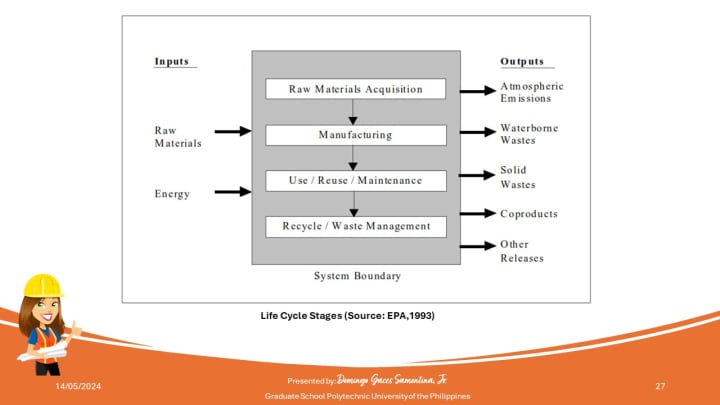
The term “life cycle” refers to the major activities in the course of the product’s life span, from its manufacture, use, and maintenance to its final disposal, including the raw material acquisition required to manufacture the product. Pictures illustrate the possible life cycle stages that can be considered in an LCA and the typical inputs and outputs measured.
References:
- Solar Energy Industries Association (SEIA). Solar Industry Research Data | SEIA
- Mulvaney, D., Act Now To Handle The Coming Wave Of Toxic PV Waste, Solar Industry Mag 2015. Accessible from URL: https://solarindustrymag.com/
- https://loadingdock.org/redo/Benefits_of_Reuse/body_benefits_of_reuse.html
- https://liftcil.org/programs/reuse.html
- Journal publication: Kim, S., Jeong, B., Closed-Loop Supply Chain Planning Model for a Photovoltaic System Manufacturer with Internal and External Recycling, Sustainability 2016, 8(7), 596. URL: https://www.mdpi.com/2071-1050/8/7/596
- Web Article: Lozanova, S., Are Solar Panels Recyclable, Earth 911, 2018. URL: https://earth911.com/eco-tech/recycle-solar-panels/(link is external)
- Web Article: Marsh, J., Recycling Solar Panels in 2018, EnergySage, 2018. URL: https://news.energysage.com/recycling-solar-panels/
PPT available here:
Like what you read?
Don't forget to please subscribe and like my story.
Thank you.
About the Creator
Domingo Añasco-Gaces Samontina, Jr.
.Professional Member of the Mechatronics and Robotics Society of the Philippines
.Certified Documented Information Controller with TUV Rheinland Qualifications
.Master of Science in Engineering (on-going) with Professional Teacher Certificate
Enjoyed the story? Support the Creator.
Subscribe for free to receive all their stories in your feed. You could also pledge your support or give them a one-off tip, letting them know you appreciate their work.






Comments
There are no comments for this story
Be the first to respond and start the conversation.